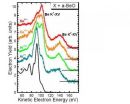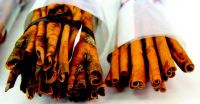(Press-News.org) Scientists are reporting the development of a simple, built-in timer intended to improve the accuracy of paper tests and test strips for diagnosing diseases inexpensively at-home and elsewhere. Their study appears in ACS' semi-monthly journal Analytical Chemistry.
Scott Phillips and Hyeran Noh note that so-called point-of-care tests include paper strip tests and others performed at home or bedside instead of in laboratories. They show special promise for improving medical care in developing countries and reducing health care costs elsewhere. When fully developed, these low-cost paper tests may replace more expensive traditional tests for detecting biomarkers in urine, blood, and other body fluids, as well as for detecting pollution in water. Many types of tests that could be used on paper, however, require precise timing using a stopwatch to provide accurate results. The authors cite as an example the CHEMCARD diagnostic test for measuring blood sugar or cholesterol in a drop of blood. It is almost 100 percent accurate when users view test results exactly 3 minutes after placing the drop of blood on the paper. Incorrect timing, however, cuts accuracy nearly in half. Patients (particularly those in the developing world), they indicate, may not have stopwatches or other timing devices, or may not use external timing devices with enough accuracy to obtain meaningful results.
The scientists describe the development of a built-in timer for paper-based diagnostic tests that eliminates the need for a stopwatch. The timer is made from a dye and the paraffin wax used in some candles. Addition of water, blood, urine or other body fluids starts the timer, and a color change signals when the time is up. The device has been modified to emit a buzz or other sound when the time is up, or even glow, the scientists note. When used with a test similar to the CHEMCARD glucose test, the timer was 97 percent accurate, slightly better than when a stopwatch was used.
INFORMATION:
The authors acknowledged funding from the Bill and Melinda Gates Foundation, the Arnold and Mabel Beckman Foundation, the Camille and Henry Dreyfus Foundation, 3M, Louis Martarano, and The Pennsylvania State University.
ARTICLE FOR IMMEDIATE RELEASE
"Fluidic Timers for Time-Dependent, Point-of-Care Assays on Paper"
DOWNLOAD FULL TEXT ARTICLE
http://pubs.acs.org/stoken/presspac/presspac/full/10.1021/ac1005537
CONTACT:
Scott Phillips, Ph.D.
Department of Chemistry
The Pennsylvania State University
University Park, Penn.16802
Phone: 814-867-2502
Fax: 814-865-5235
Email: sphillips@psu.edu
Built-in timer for improving accuracy of cost saving paper-strip medical tests
2010-11-04
ELSE PRESS RELEASES FROM THIS DATE:
Does adolescent stress lead to mood disorders in adulthood?
2010-11-04
Montreal, November 3, 2010 – Stress may be more hazardous to our mental health than previously believed, according to new research from Concordia University. A series of studies from the institution have found there may be a link between the recent rise in depression rates and the increase of daily stress.
"Major depression has become one of the most pressing health issues in both developing and developed countries," says principal researcher Mark Ellenbogen, a professor at the Concordia Centre for Research in Human Development and a Canada Research Chair in Developmental ...
Electrons get confused
2010-11-04
Scientists from Helmholtz-Zentrum Berlin (HZB) observed exotic behaviour from beryllium oxide (BeO) when they bombarded it with high-speed heavy ions: After being shot in this way, the electrons in the BeO appeared "confused", and seemed to completely forget the material properties of their environment. The researchers' measurements show changes in the electronic structure that can be explained by extremely rapid melting around the firing line of the heavy ions. If this interpretation is correct, then this would have to be the fastest melting ever observed. The researchers ...
Levels of coumarin in cassia cinnamon vary greatly even in bark from the same tree
2010-11-04
A "huge" variation exists in the amounts of coumarin in bark samples of cassia cinnamon from trees growing in Indonesia, scientists are reporting in a new study. That natural ingredient in the spice may carry a theoretical risk of causing liver damage in a small number of sensitive people who consume large amounts of cinnamon. The report appears in ACS' bi-weekly Journal of Agricultural and Food Chemistry.
Friederike Woehrlin and colleagues note that cinnamon is the second most popular spice, next to black pepper, in the United States and Europe. Cinnamon, which comes ...
Small materials poised for big impact in construction
2010-11-04
Bricks, blocks, and steel I-beams — step aside. A new genre of construction materials, made from stuff barely 1/50,000th the width of a human hair, is about to debut in the building of homes, offices, bridges, and other structures. And a new report is highlighting both the potential benefits of these nanomaterials in improving construction materials and the need for guidelines to regulate their use and disposal. The report appears in the monthly journal ACS Nano.
Pedro Alvarez and colleagues note that nanomaterials likely will have a greater impact on the construction ...
Transparent conductive material could lead to power-generating windows
2010-11-04
UPTON, NY - Scientists at the U.S. Department of Energy's (DOE) Brookhaven National Laboratory and Los Alamos National Laboratory have fabricated transparent thin films capable of absorbing light and generating electric charge over a relatively large area. The material, described in the journal Chemistry of Materials, could be used to develop transparent solar panels or even windows that absorb solar energy to generate electricity.
The material consists of a semiconducting polymer doped with carbon-rich fullerenes. Under carefully controlled conditions, the material self-assembles ...
Video-game technology may speed development of new drugs
2010-11-04
Parents may frown upon video games, but the technology used in the wildly popular games is quietly fostering a revolution in speeding the development of new products and potentially life-saving drugs. That's the topic of an article in the current issue of Chemical & Engineering News (C&EN), ACS' weekly newsmagazine.
C&EN Associate Editor Lauren K. Wolf notes that consumer demand for life-like avatars and interactive scenery has pushed computer firms to develop inexpensive yet sophisticated graphics hardware called graphics processing units, or GPUs. The graphical units ...
PET scans reveal estrogen-producing hotspots in human brain
2010-11-04
UPTON, NY - A study at the U.S. Department of Energy's (DOE) Brookhaven National Laboratory has demonstrated that a molecule "tagged" with a radioactive form of carbon can be used to image aromatase, an enzyme responsible for the production of estrogen, in the human brain. The research, published in the November issue of Synapse, also uncovered that the regions of the brain where aromatase is concentrated may be unique to humans.
"The original purpose of the study was to expand our use of this radiotracer, N-methyl-11C vorozole," said Anat Biegon, a Brookhaven neurobiologist. ...
Scientists develop method to keep surgically-removed prostate tissue alive and 'working' for week
2010-11-04
Scientists at the Johns Hopkins Kimmel Cancer Center, University of Helsinki and Stanford University have developed a technique to keep normal and cancerous prostate tissue removed during surgery alive and functioning normally in the laboratory for up to a week.
The new technique could not only enhance research of prostate biology and cancer, but also hasten the creation of individualized medicines for prostate cancer patients, the investigators say. Previous attempts to culture live prostate tissues resulted in poor viability and lost "tissue architecture," the researchers ...
Rice U. study looks at marketing benefits, pitfalls of customer-satisfaction surveys
2010-11-04
Though designed to enhance customer experiences, post-service customer surveys might actually harm a business's relationships with consumers, according to new research by Rice University professors. The research team found that customers who participate in firm-sponsored surveys delay doing repeat business with that company.
The study finds companies that use immediate follow-up customer surveys or multiple follow-up surveys may open themselves to negative consequences because customers who were satisfied with the specific service they received may jump to the conclusion ...
Multifocal contact lenses may reduce vision for night driving
2010-11-04
A new study suggests that older adults who wear multifocal contact lenses to correct problems with near vision, a very common condition that increases with age, may have greater difficulty driving at night than their counterparts who wear glasses. Age-related problems with near vision, medically termed presbyopia, usually occurs after the age of 40 and results in the inability to focus on objects up close.
According to an article published in Investigative Ophthalmology & Visual Science ("The Effect of Presbyopic Vision Corrections on Nighttime Driving Performance"), ...



